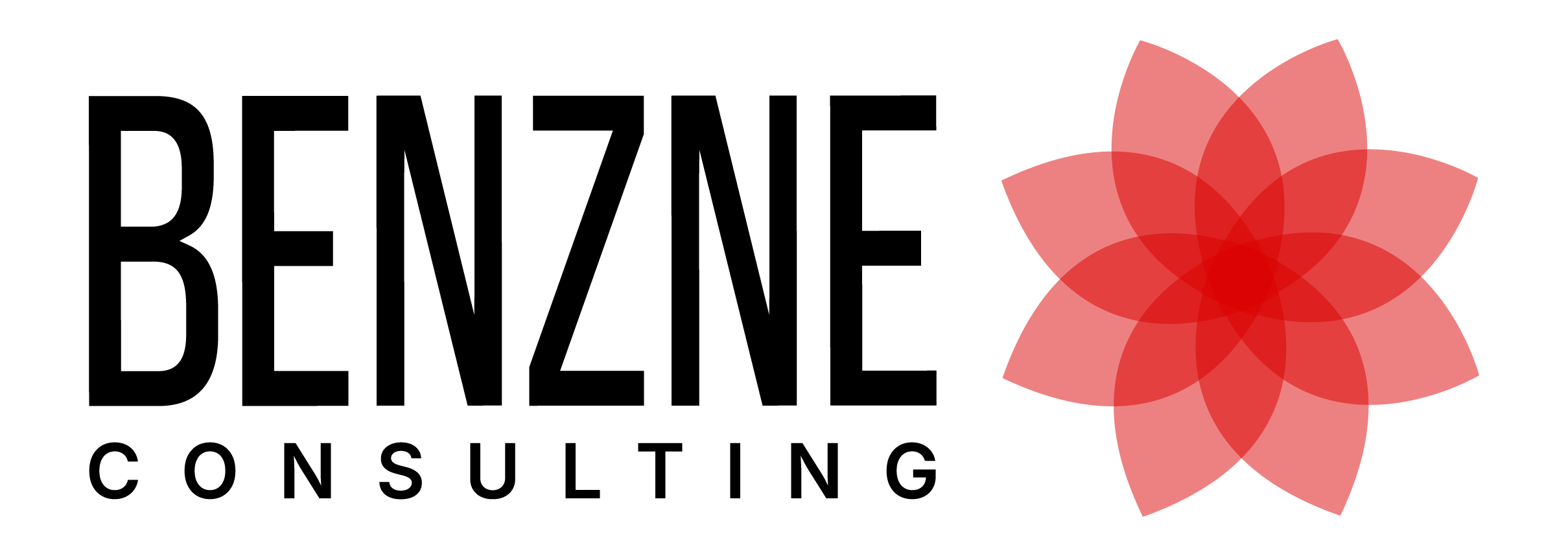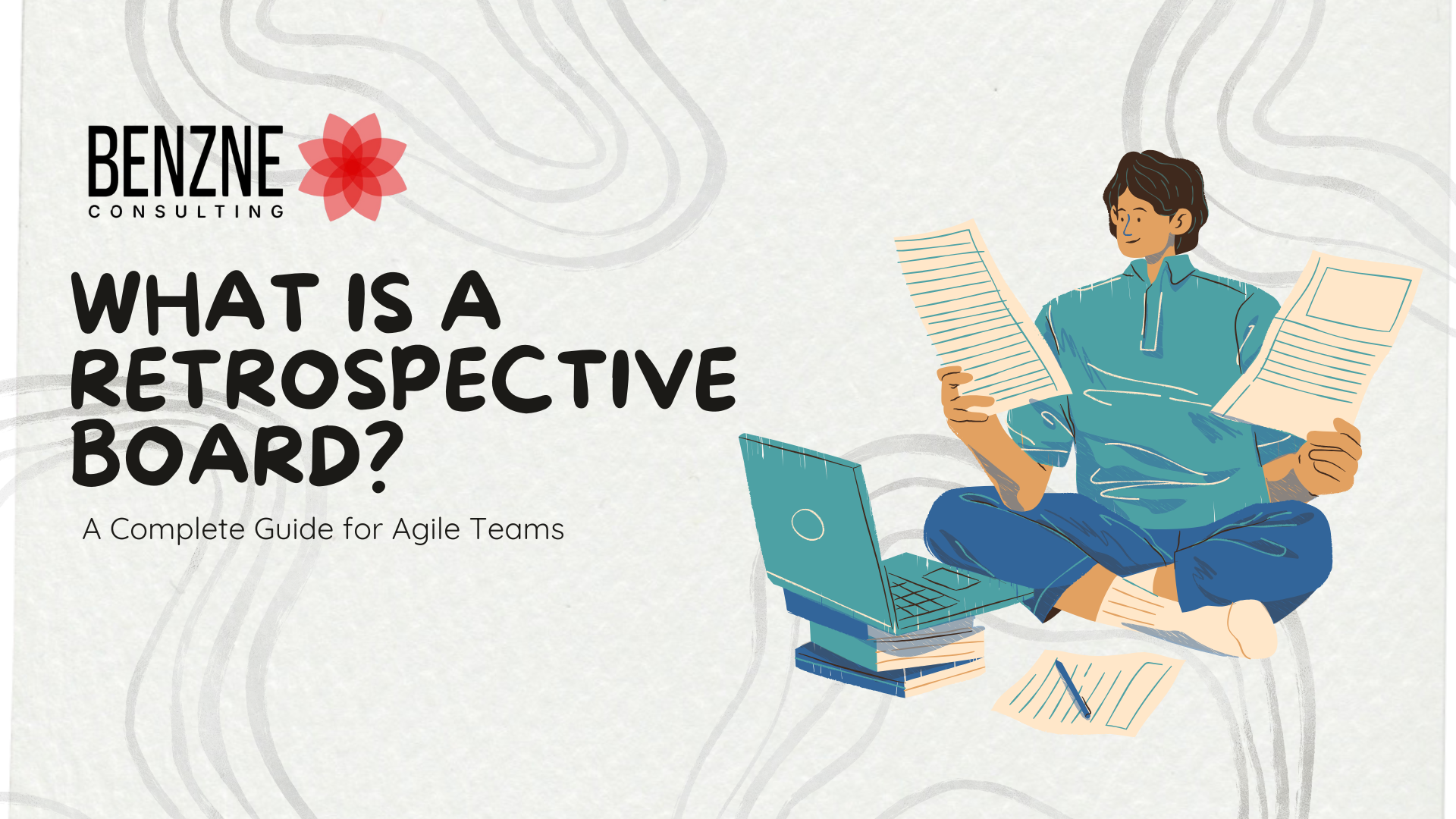Introduction
One of the most important principles of agile is to Inspect and Adapt. Agile helps teams with multi level opportunities for inspecting and adapting. While in every cadence there is an opportunity for the product to increment there is also an equal opportunity for people and process to increment. Sprint retrospective is one of the vital ceremonies which teams use in order to continuously identify gaps with respect to people/process and to improve them. There are thousands of templates and ways to do retrospectives. One thing common in any type or retrospective is the usage of retrospective boards to facilitate the ceremony.
Think of a retrospective board as your team’s mirror. It does not just reflect what happened, it also ensures teams to see why it happened and how you felt about it. Retrospective boards, helps teams with one critical insight that is what can you do differently next time. Without these boards, teams are like ships sailing blindly, repeating the same mistakes and feeling the same frustrations.
With this in mind and retrospective board being crucial for teams, let’s explore:
- What exactly is a retrospective board and why to use it?
- Types of retrospective boards and some most used formats
- How to use retrospective boards in agile from setup till acting on the points?
- Few examples of retrospective boards
What is a Retrospective Board?
A retrospective board is a visual workspace where a team gathers data points to reflect on their experience in every sprint, project phase or a specific event. It provides structure to discussions by allowing team members to share:
- How was their experience in the previous cadence?
- Where are the gaps in the teams?
- Action items to improve them
A retrospective board is where honest feedback facilitates creative problem solving and in which everyone in the team can contribute.
Why Use a Retrospective Board?
Most of the teams try to do their retrospective by just talking or typing notes into a document. While this may not be sufficient, retrospective boards give you clear, sprint level insights and are easily trackable.
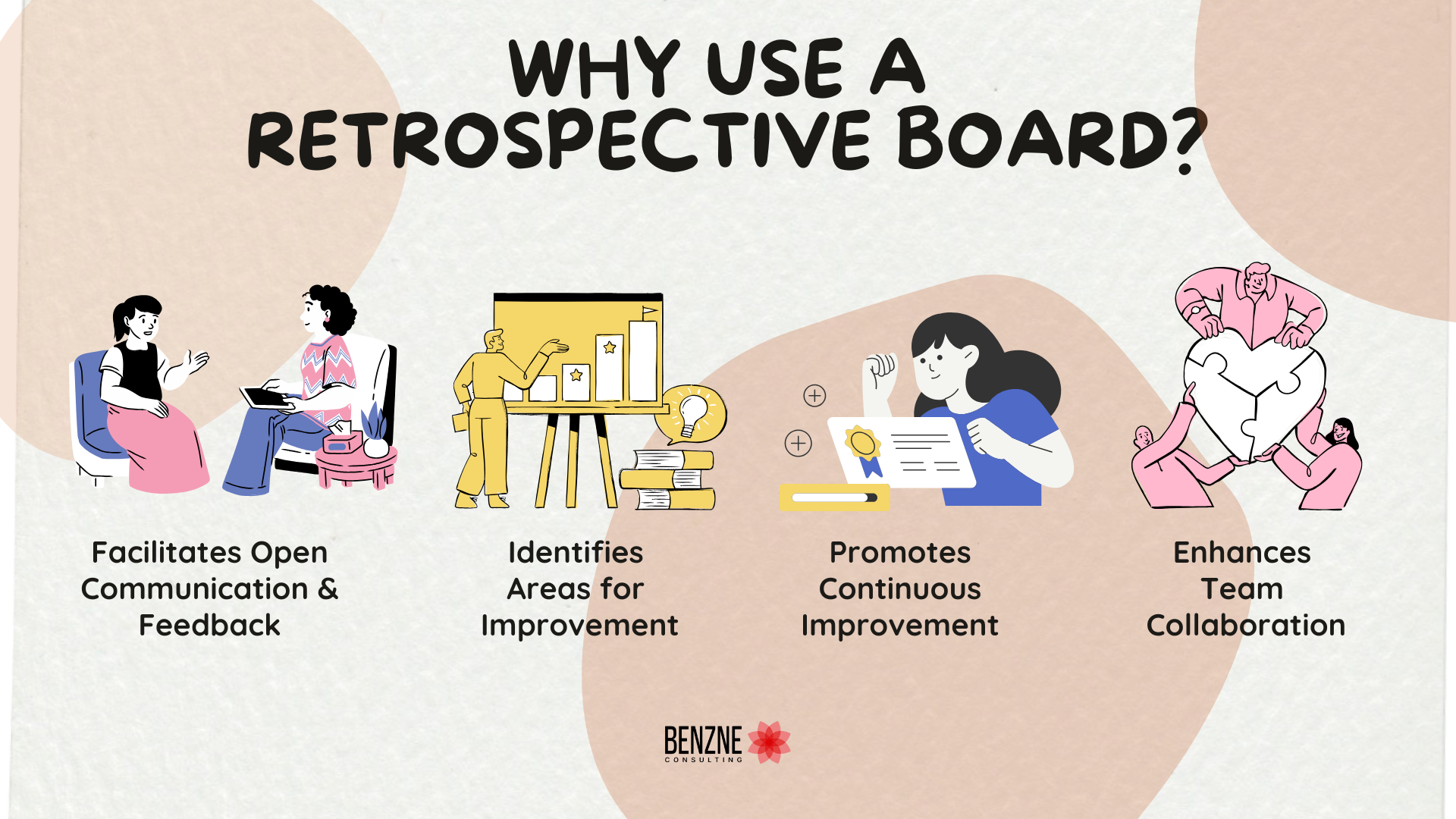
Facilitates Open Communication and Feedback
Remember those days when the teacher asked “Any questions?” and none of us raised their hands. Retrospective boards solve that problem by creating a safe environment where team members can share honest feedback without pressure of speaking up in front of everyone. A well structured board gives every team member a voice. Especially the digital tools with anonymous features creates that space where everyone can share their opinion freely.
Identifies Areas for Improvement
Without a clear visual representation, themes get lost. The board helps in identifying patterns. Imagine if 5 people write “unclear requirements”. It immediately surfaces as a pattern. These are the clear signals for where the gaps are and what you need to improve on. The boards make it easier to spot the problem areas.
Promotes Continuous Improvement
Continuous improvement is like the vital aspect of agility. It is not about improving once. Retrospective boards make improvement a habit. They help run the ceremony as a ritual that drives improvement continuously and makes it convenient for the teams to facilitate.
Enhances Team Collaboration
A retrospective using a board is not just about sharing feedback. It is about collective problem solving. Boards give a lot of features like clustering similar ideas, discuss root causes and voting to brainstorm solutions. The shared ownership of problems and solutions enables teams to bond and build one team mindset.
Types of Retrospective Boards
There are thousands of templates and ways in which teams can do retrospective. Teams, based on their work dynamics can opt out to either use a physical board or digital boards for their retrospective.
Physical Boards
- How – Using whiteboards, flip charts, or a glass wall
- Support – with the help of multi colour Sticky notes, markers and sketch pens
- Pros – Highly engaging, great for co located teams and easy for everyone to see simultaneously
- Cons – Not ideal for distributed teams, anonymity can be a challenge, notes can get misplaced, requires cleaning up
Digital Boards
- How – Using online tools like Ideaboardz, Easy retro, Mural, Trello, Jira, Azure Devops
- Support – With the help of communication tools like Teams, Zoom, Google meet etc
- Pros – Ideal for distributed teams, allows anonymity, easy to share outcomes, can also be integrated with other tools, comes up pre defined templates
- Cons – Team members may be lost, requires learning curve, might not be as engaging as the physical boards
Hybrid Boards
- How – Using a mix of online tools and a physical board. For example, two people are working from home may contribute in a digital board or a physical board is quickly captured on the phone and uploaded on the digital board with transcription
- Support – With the help of communication tools like Teams, Zoom, Google meet with whiteboards, glass walls etc
- Pros – Ideal for distributed teams, Might be a flexible options when teams have to do retrospective in parallel
Different Retrospective Board Formats with Examples of Retro Boards
As mentioned above, there are so many styles and templates for teams to do retrospective. While teams can either choose a template which suits them or even go with a different template each time they do a retrospective, the intention remains the same with the agenda of reflecting back on their previous sprint and improving . But let’s see some of the of most used templates and styles,
Start-Stop-Continue
- Sections / Columns – “Start Doing”, “Stop Doing” and “Continue Doing”
- Focus – Action oriented, Simple to understand and direct action items. Great for teams new to retrospectives or when you need quick and clear actions
- Example
- Start Doing – Daily 15 mins sync meeting
- Stop Doing – ad hoc interruptions during focus time
- Continue doing – pair programming for complex tasks
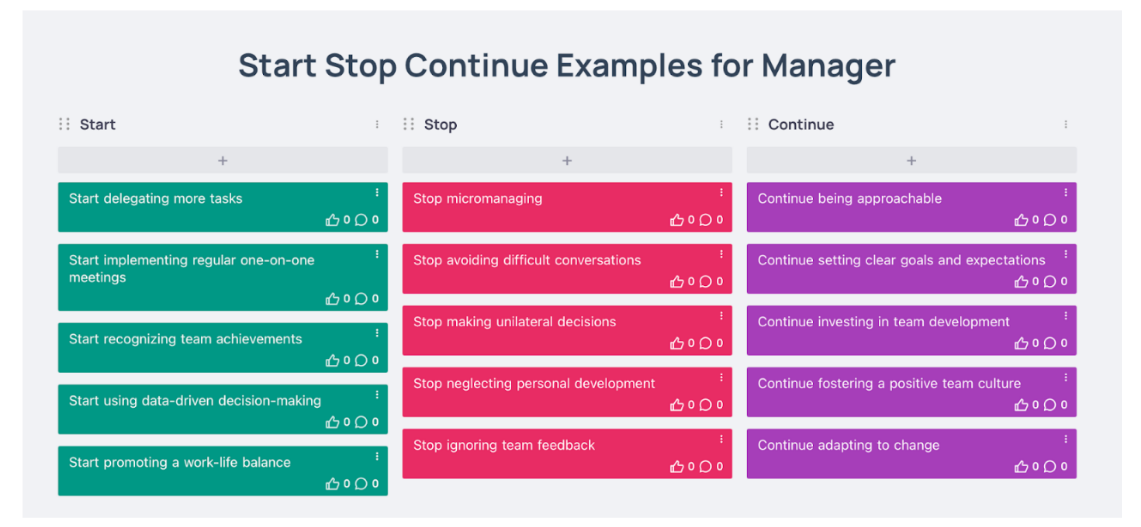
Mad-Sad-Glad
- Sections/Columns – “Mad”(What frustrates us?), “Sad”(What disappointed us?), “Glad”(What made us happy”)
- Focus – Emotional tone, helps bring up underlying feelings and morale issues, great for building psychological safety
- Examples
- Mad – “last minute requirement changes”
- Sad – “Not being able to complete critical story due to blockers”
- Glad – “Successful deployment without major bugs”
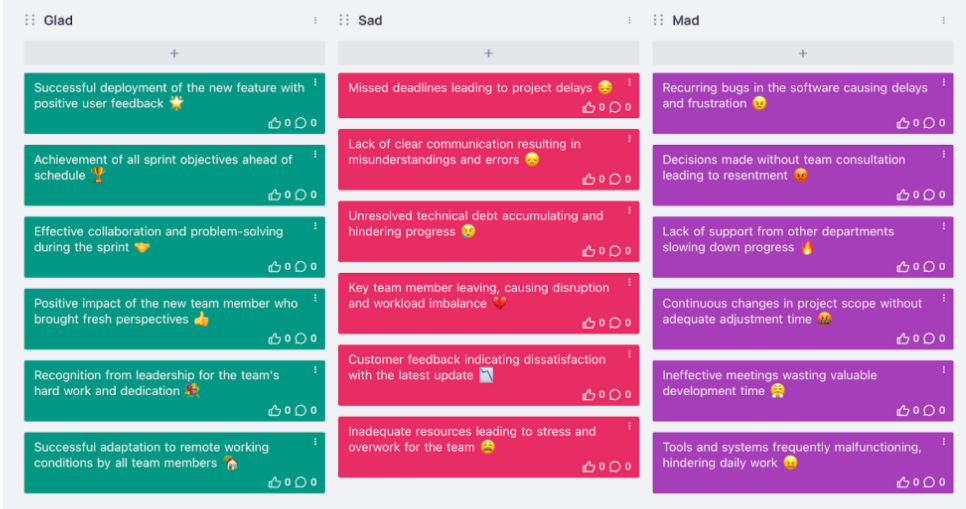
4Ls (Liked, Learned, Lacked, Longed for)
- Sections/Columns – “Liked”(What did we enjoy?), “Learned”(What new insights did we gain?), “Lacked”(What was missing?), “Longed for”(What do we wish we had?)
- Focus – Comprehensive reflection, Covers positive aspects, growth, gaps and aspirations
- Example –
- Liked – Clear user stories in the sprint
- Learned – How to use new testing tool
- Lacked – Enough time for proper code review
- Longed for – More direct feedback from the end users
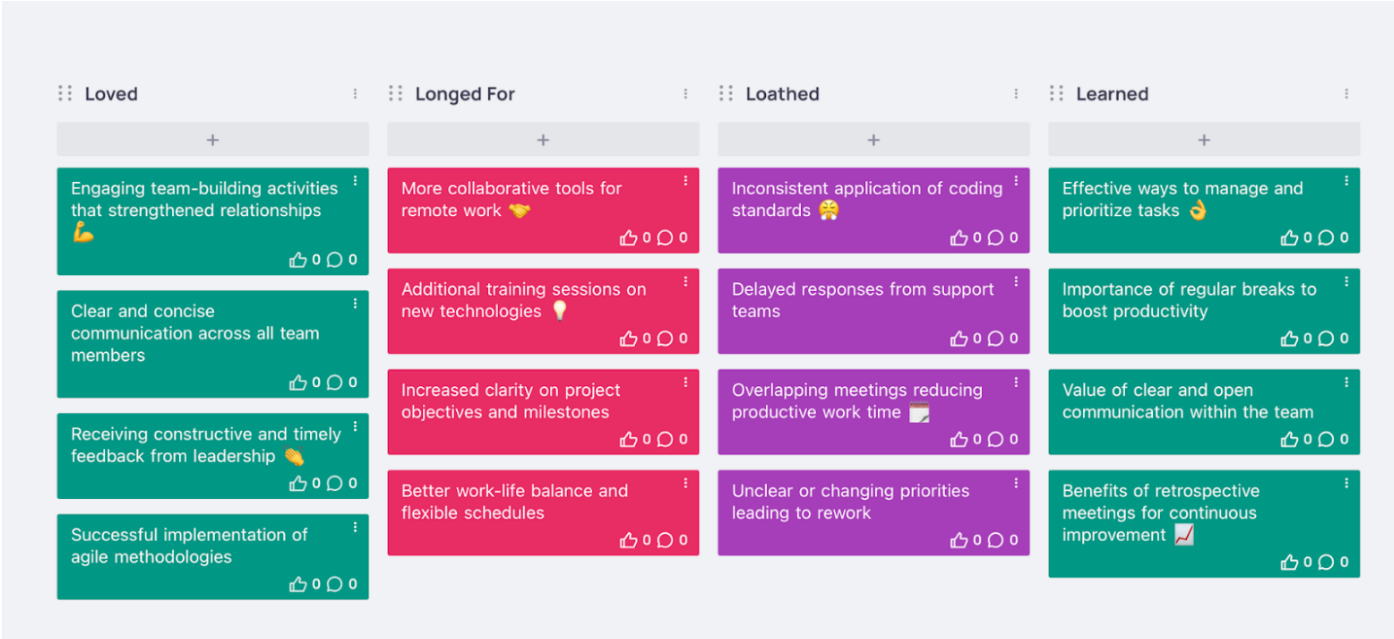
Sailboat or Speedboat method
- Analogy is that the team is a sailboat
- Sections/Columns – “Sail/Wind”(What pushed us forward – Positive?), “Anchor”(What held us back?), “Rock/Icebergs”(What potential risks are ahead?), “Island/Destination”(What is our goal?)
- Focus – Visual and metaphorical. Excellent for engaging and identifying both current blockers and future risks
- Examples –
- Sail/wind – Strong team spirit and collaboration
- Anchor – Lack of clear priorities
- Rock/Icebergs – Dependency on third party vendor
- Island/Destination – Launch the new product and increase the customer base
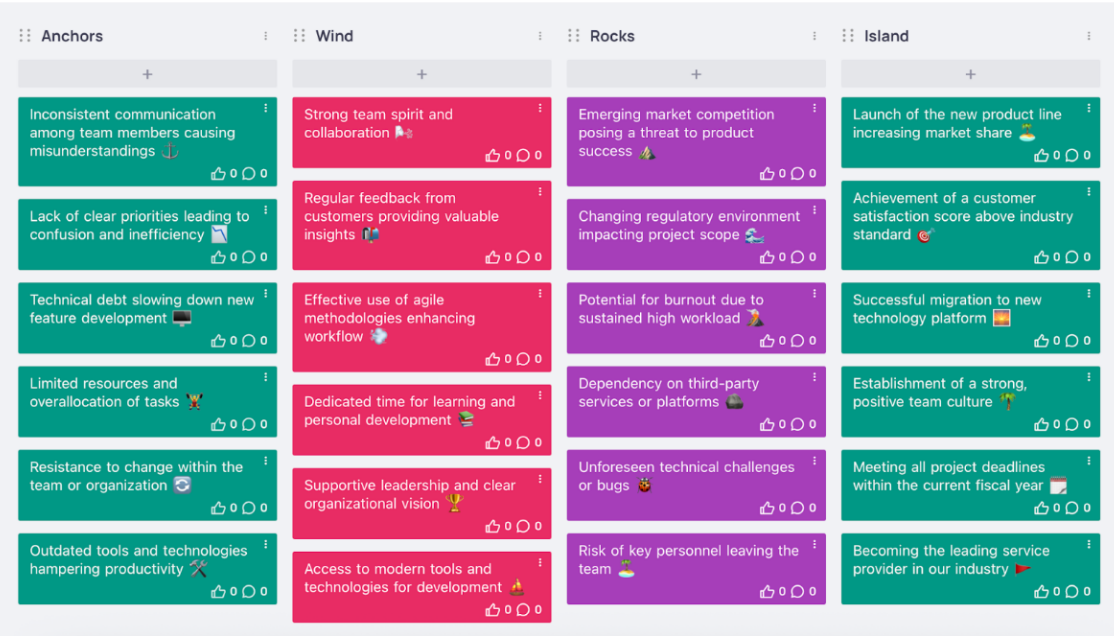
DAKI (Drop, Add, Keep, Improve)
- Sections/Columns – “Drop”(What to eliminate?), “Add”(What new things to introduce?), “Keep”(What is working well?), “Improve”(What needs refinement?)
- Focus – Clear and actionable changes for processes and tools or behaviors
- Example –
- Drop – Unnecessary daily email updates
- Add – A dedicated “DOD” session
- Keep – Our Sprint planning format
- Improve – Our Ci/CD pipeline efficiency

Custom templates for different teams
While there are so many styles and templates for a retrospective board, teams can also bring in their flavour and make their own template to use which makes sense for them. For example, if your team has a specific recurring challenge, for instance communication with external teams, dedicate a column to them. The best template is the one that best serves your team’s current needs.
The Role of Retrospective Boards in Agile Methodologies
Retrospective boards are the best way of viewing a team’s intent of agility. In scrum, the sprint retrospective is a formal event that concludes each sprint. The board is the central artefact of this event. In kanban teams may use it for regular service delivery reviews. Even with SAFe, scaled retrospectives often use similar visual tools. Retro Boards:
- Bridges the gap between talking about the problem and solving the problems
- Brings in autonomy for everyone to share their opinions freely
- Enables teams with an opportunity to be more collaborative
- Turns challenges into opportunities
How to Run a Retrospective Using a Board – Step-by-step guide?
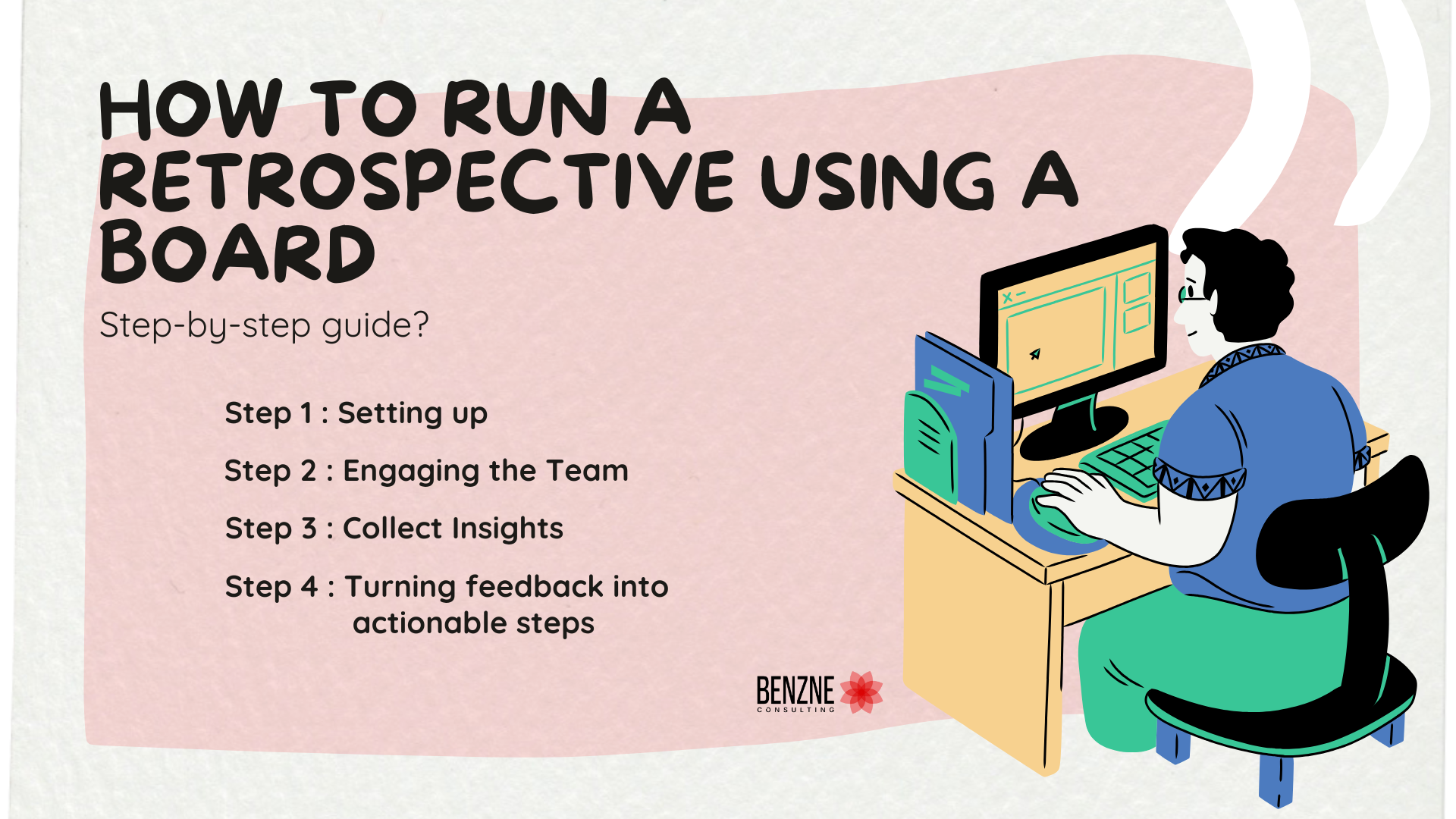
Step 1 : Setting up
- Choose your format and the tool – Based on your team’s needs and location, draw/setup the sections clearly
- Set the Stage – As a facilitator, brief and set the agenda to the team on the purpose of the retro. Explain the format chosen clearly until everyone is on the same page. Remind the reams that retro is confidential to create safe environment
- Define the Timebox – Explain how long will the retro last for and time dedicated for each section and step in the retro
Step 2 : Engaging the Team
Start with an icebreaker or energize everyone to ensure the right environment is set. Explain the format clearly and give examples if needed. Creating a psychological safe environment is crucial in this step. Team members need to feel safe to share their opinions and suggestions freely.
Step 3 : Collect Insights
Give everyone time to add their thoughts. We usually give around 7-10 mins for everyone to add their thoughts into the columns. This prevents group thinking and ensures everyone’s initial thoughts are captured.
How to ensure open and honest discussions?
- Remind everyone that no matter what, everyone understands that we did a good job
- By creating a Safe environment. Remind the team members about the fact that retro is about improving the system not blaming others
- Facilitator guides the process, asking/probing questions and ensures everyone gets a voice
Step 4 : Turning feedback into actionable steps
- Spend some time to group similar points
- Give team votes to help them prioritize top priority points
- Take the top 3-5 most voted points
- For each point, brainstorm the action item and define it
- Assign owners and due dates for the action items
Conclusion
Retrospective boards are not just a tool, it is proof of a team’s pursuit towards commitment and self improvement. Retrospective boards have helped teams reflect their problems and move from just talking about problems to actually solving them. Retrospective boards brings everyone in the team together to collectively solve their problems with collaboration and one team mindset.
The Key is finding the right format for your team, creating a psychological safe environment and most importantly following through on the insights you have gathered. There are thousands of retro styles and templates in the market. What becomes important is to understand the intention behind the ceremony, what are your needs, how are your teams located and then to choose the right template which suits your team dynamics.
With this, our blog on “What is a Retrospective Board? A Complete Guide for Agile Teams” comes to an end and we sincerely hope it has helped our readers in gaining insights. Please write to us at “consult@benzne.com” for any feedback, suggestions or if you would like to talk to Benzne consulting team for solving specific problems, check Benzne Agile consulting services.
Frequently Asked Questions about Retrospective Board
1. How often should teams conduct retrospectives using a board?
As often as the team needs. In frameworks like Scrum, there is a formal ceremony teams will have to do with which a sprint gets concluded. But in frameworks like Kanban, the team may decide a cadence to do a retrospective based on the need. However, teams can also do retrospectives at various stages, say for example, a big milestone release or even after an event.
2. Can a retrospective board be used in non-Agile teams?
Yes absolutely. Retrospective boards are visual representation and a proof of a team’s commitment towards continuous improvement. So wherever there is continuous improvement needed and the teams are looking to reflect be it HR, Finance, Manufacturing or any domain for that matter, retrospective boards can be used.
3. Can we customize a retrospective board based on team preferences?
Absolutely. The best retrospective board is the one which makes sense to the team. You can create a new template, choose one from the market and opt to customize them based on your team’s preference and dynamics.
4. Who facilitates a retrospective meeting using a board?
A scrum master is the role dedicated to facilitate all the ceremonies in a sprint. However, team can also choose a person to facilitate the retro and give a chance for everyone in the team to take turns in terms of facilitation.
